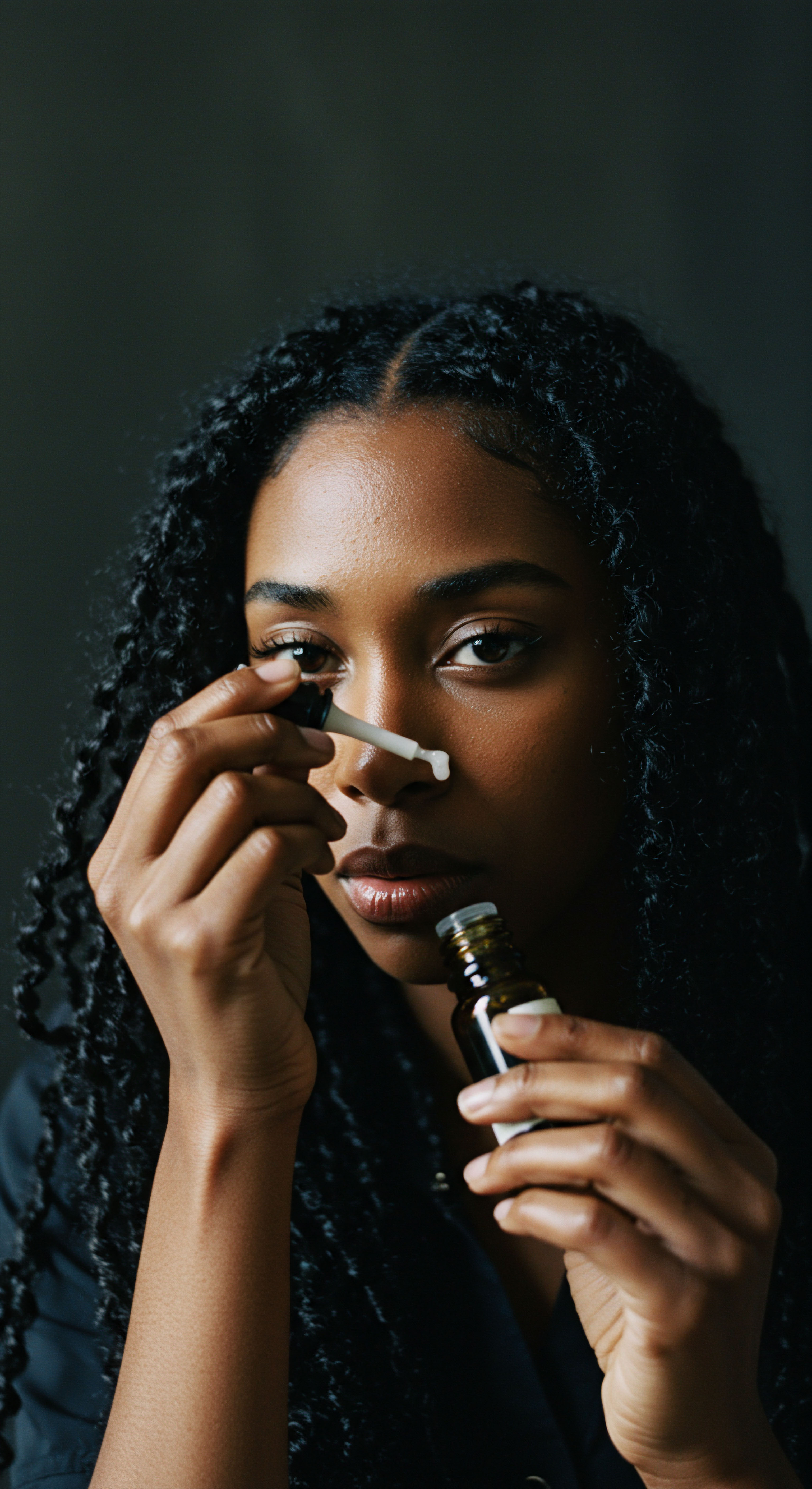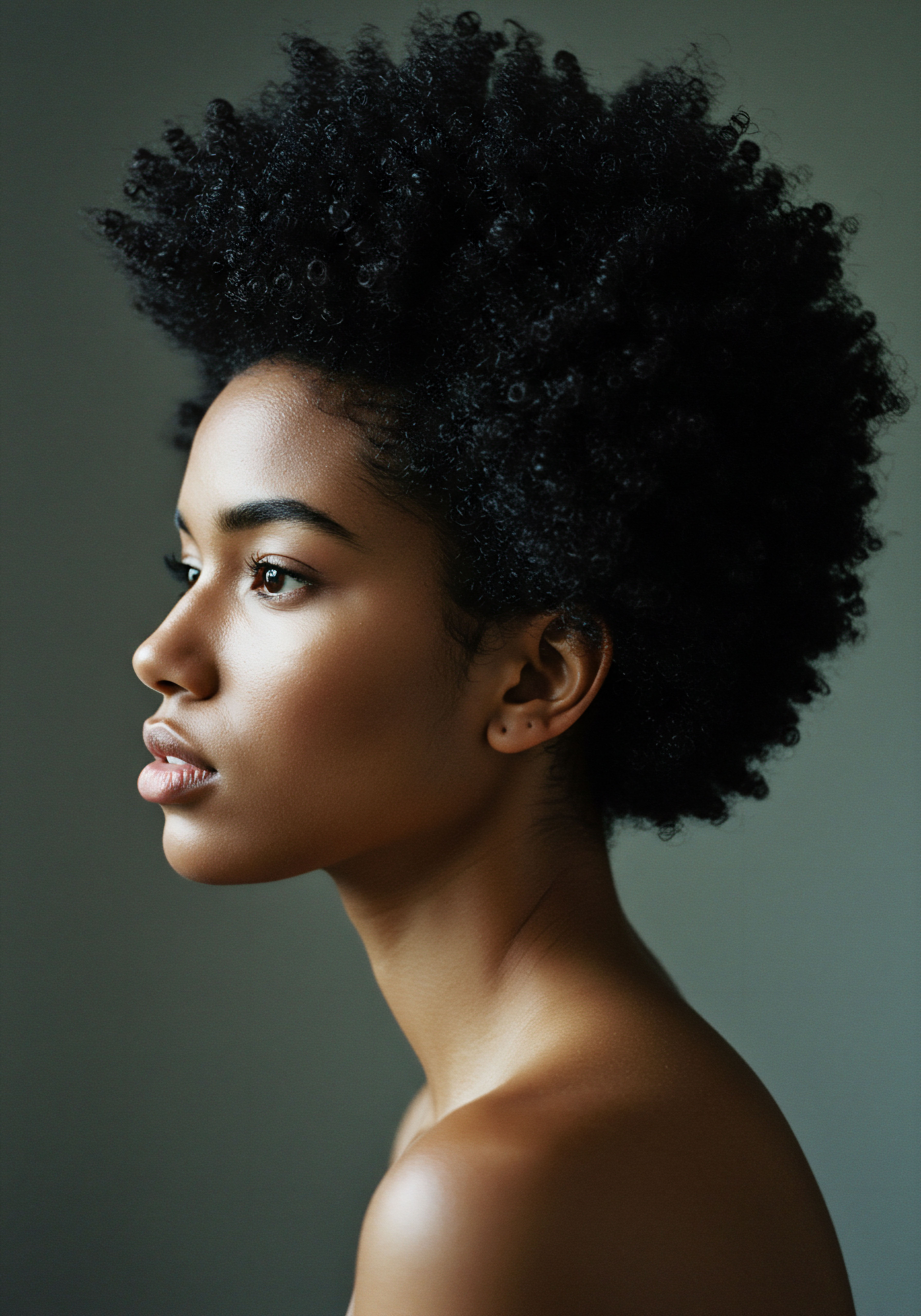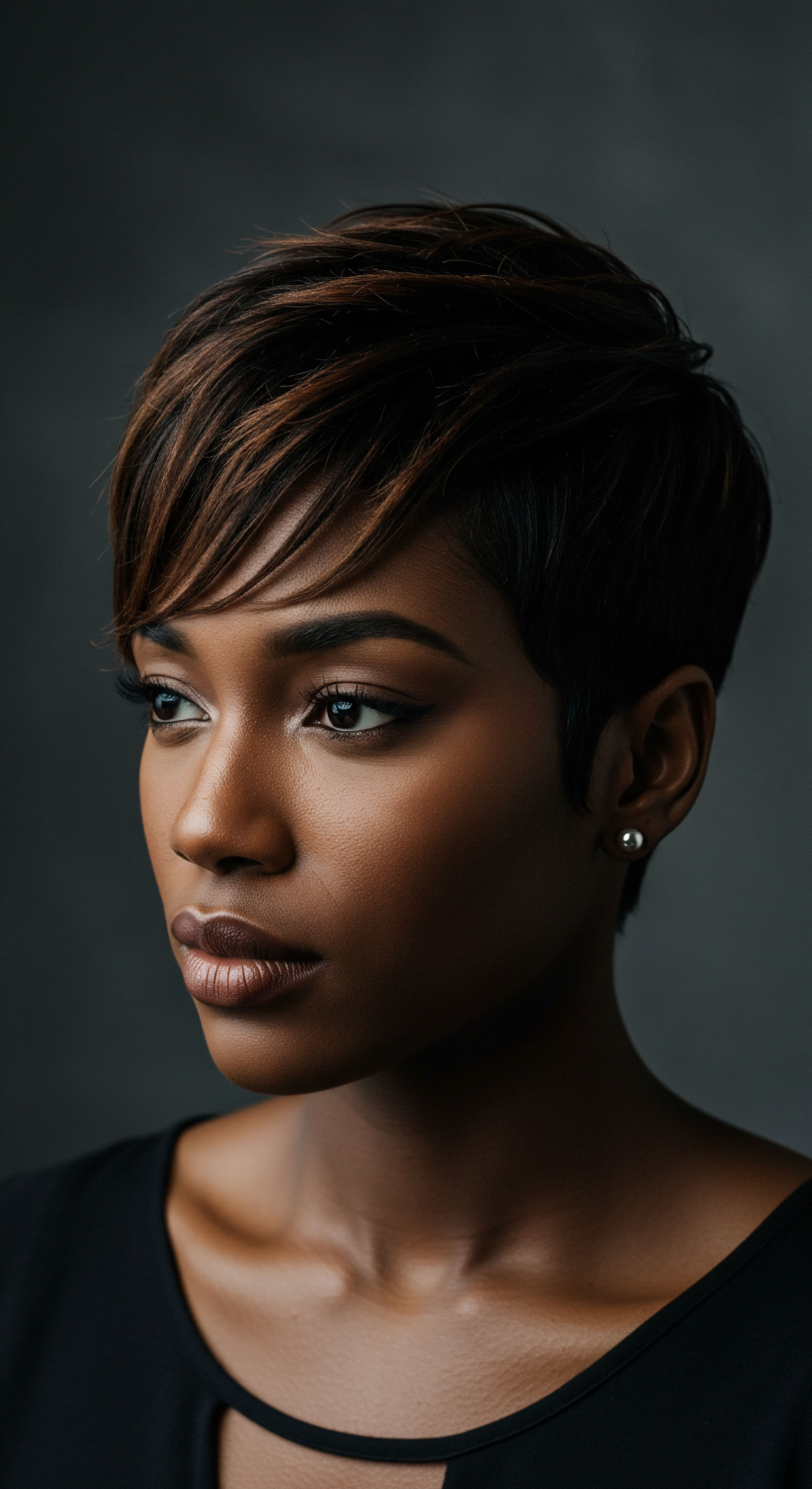
Roots
The whisper of the atmosphere, often an unseen presence, plays a profound role in the very being of textured hair. We often sense it – a sudden lightness or a curious resistance in our strands – a direct conversation between our hair and the surrounding air. This quiet observation, shared across generations and geographies, speaks to a fundamental truth ❉ hair, a living extension of ourselves, responds with exquisite sensitivity to its environment. To truly comprehend how humidity shapes textured hair’s daily hydration needs, we must first descend into the very architecture of a strand, understanding its elemental makeup and the forces that govern its relationship with water.
Consider the hair shaft, seemingly simple, yet a marvel of biological engineering. At its core lies the Cortex, a bundle of keratin proteins that grant hair its strength and elasticity. Encasing this cortex are layers of overlapping cells, much like shingles on a roof, forming the Cuticle.
The cuticle serves as hair’s primary shield, regulating the passage of substances into and out of the inner structure. The arrangement and integrity of these cuticle scales are paramount, particularly for textured hair, where the natural curl pattern often leads to areas where the cuticle is naturally more raised, or where mechanical manipulation causes it to lift.
Beyond the cuticle, a delicate film of lipids and proteins coats the hair surface, known as the Sebum Layer. This natural conditioning agent, produced by the scalp’s sebaceous glands, acts as a hydrophobic barrier, helping to seal in moisture and protect the hair from external aggressors. The efficacy of this barrier varies considerably across individuals and hair types, influencing how readily hair gains or loses water from the atmosphere.
Hair’s structural components, from cortex to cuticle, orchestrate its unique interaction with atmospheric moisture.

The Essential Lexicon of Textured Hair
To discuss textured hair with precision, a shared language becomes essential. Terms such as Porosity, Elasticity, and Curl Pattern are not mere descriptors; they are keys to unlocking a deeper understanding of hair’s behavior. Porosity refers to hair’s ability to absorb and retain moisture, directly linked to the state of its cuticle. Hair with a tightly sealed cuticle possesses low porosity, while a raised or damaged cuticle indicates high porosity.
Elasticity, the hair’s capacity to stretch and return to its original state without breaking, signals its internal health and protein balance. Curl pattern, often categorized using systems that classify hair from straight (Type 1) to coily (Type 4), guides our approach to cleansing, conditioning, and styling.
Understanding these foundational terms provides a framework for recognizing how hair responds to its surroundings. A strand with high porosity, for instance, may readily absorb water from humid air, but also release it just as quickly when the air becomes dry, leading to cycles of swelling and contraction. This constant fluctuation can stress the hair, affecting its structural integrity over time.

Hair Growth Cycles and Influencing Factors
Hair growth is a continuous cycle, moving through three distinct phases ❉ anagen (growth), catagen (transition), and telogen (resting). While humidity does not directly alter these intrinsic biological rhythms, the health of the hair shaft, which is significantly influenced by environmental conditions, impacts how long hair remains in its anagen phase and its overall resilience against breakage. A consistent, supportive environment for hair, including appropriate hydration, helps to sustain healthy growth and minimize premature shedding.
Factors beyond humidity also play a role in hair’s inherent properties. Genetics dictate the curl pattern and general density. Internal factors, such as diet, hydration, and overall health, contribute to the hair’s vitality. External factors, including mechanical manipulation, chemical treatments, and, of course, environmental humidity, interact with these intrinsic qualities, creating a complex interplay that determines hair’s daily demeanor and long-term health.
| Hair Component Cuticle |
| Function Protective outer layer, regulates moisture. |
| Humidity Interaction Lifts in high humidity, closes in low humidity. |
| Hair Component Cortex |
| Function Inner core, provides strength and elasticity. |
| Humidity Interaction Swells with water absorption, contracts with water loss. |
| Hair Component Sebum Layer |
| Function Natural lipid barrier, seals moisture. |
| Humidity Interaction Impacts how readily hair absorbs or loses atmospheric water. |
| Hair Component The health of each component influences hair's hydration balance. |

Ritual
Every touch, every product chosen, every styling choice forms a quiet conversation with our hair, a series of deliberate acts that shape its daily reality. This daily or periodic engagement with our strands, often deeply personal and culturally informed, becomes particularly significant when we consider the ever-present influence of atmospheric moisture. How do we move from understanding hair’s fundamental architecture to truly supporting its needs amidst the ebb and flow of environmental factors? The answer lies in the conscious practice of hair care rituals, refined to acknowledge the delicate balance humidity demands.
When humidity climbs, the air becomes saturated with water vapor. For textured hair, especially those strands with higher porosity, this atmospheric water can be readily absorbed. While a certain level of moisture is desirable for flexibility and preventing breakage, an excessive influx can lead to the hair shaft swelling.
This swelling, when unchecked, causes the cuticle scales to lift, resulting in a loss of definition and the characteristic expansion we know as frizz. Conversely, in dry environments, hair can quickly lose its internal water content to the parched air, leading to dryness, brittleness, and an increased propensity for breakage.

Building Personalized Textured Hair Regimens
A regimen tailored to one’s unique hair characteristics and local climate is not a luxury; it is a necessity. The core of any effective routine for textured hair revolves around cleansing, conditioning, and sealing.
- Cleansing ❉ Opt for sulfate-free cleansers that gently remove impurities without stripping hair of its natural oils. For those in consistently humid climates, a slightly stronger clarifying cleanse might be needed periodically to prevent product buildup, which can weigh hair down and attract more moisture.
- Conditioning ❉ Deep conditioning is the cornerstone of hydration. Regular deep treatments replenish moisture lost to environmental factors and daily manipulation. Look for conditioners rich in humectants like glycerin (used judiciously based on humidity levels) and emollients such as shea butter or coconut oil, which provide a protective coating.
- Sealing ❉ This step is vital for retaining the moisture infused during conditioning. After applying a leave-in conditioner, follow with a heavier oil or butter. This creates a barrier, slowing down the rate at which water leaves the hair in dry conditions or prevents excessive water absorption in humid ones.

The Nighttime Sanctuary Essential Sleep Protection
The hours we spend asleep offer a profound opportunity for hair preservation. Neglecting nighttime care can undo the efforts of a meticulous daytime routine, especially for textured hair prone to tangling and moisture loss. The friction between hair and absorbent pillowcases can strip strands of their vital hydration and disrupt delicate curl patterns.
This is where the wisdom of a bonnet, or a silk/satin pillowcase, becomes evident. These accessories create a protective cocoon for hair, reducing friction and minimizing moisture evaporation. Unlike cotton, which absorbs moisture, silk and satin allow hair to retain its hydration, preserving its integrity and style for the day ahead. This simple ritual safeguards the hair’s delicate structure against the rigors of movement during sleep, contributing significantly to its overall health and manageability.
Thoughtful nighttime rituals protect textured hair from friction and preserve its precious moisture.

Ingredient Choices for Variable Climates
The efficacy of hair care ingredients is not static; it shifts with the atmospheric conditions. Humectants, for example, are molecules that draw moisture from the air. In moderately humid environments, they can be beneficial, pulling water into the hair shaft and keeping it supple.
However, in extremely high humidity, humectants can cause hair to swell excessively, leading to frizz. Conversely, in very dry climates, humectants may draw moisture out of the hair if the air is drier than the hair itself, exacerbating dryness.
For highly humid conditions, products that form a protective film, such as those containing silicones or certain polymers, can help seal the cuticle and prevent excessive water absorption. In arid climates, a layered approach with hydrating leave-ins followed by occlusive oils or butters becomes paramount to seal in moisture and prevent its escape. The choice of ingredients is a dance with the climate, a continuous adjustment to maintain hair’s internal equilibrium.
| Humidity Level Low (Arid) |
| Hair Behavior Hair loses moisture, feels dry, brittle. |
| Hydration Strategy Deep conditioning, occlusive oils, minimal humectants. |
| Humidity Level Moderate |
| Hair Behavior Hair maintains balance, can benefit from humectants. |
| Hydration Strategy Balanced routine, humectants in moderation. |
| Humidity Level High (Humid) |
| Hair Behavior Hair absorbs excess water, frizzes, loses definition. |
| Hydration Strategy Film-forming products, lighter humectants, sealing. |
| Humidity Level Adapting care to climate preserves hair health. |

Relay
To truly grasp the intricate interplay between atmospheric conditions and textured hair’s thirst, we must transcend surface observations and delve into the scientific underpinnings that govern this dynamic relationship. How does the very architecture of textured hair respond at a molecular level to the presence or absence of water in the air, and what hidden truths about its hydration needs does this reveal? This exploration demands a synthesis of biological understanding, cosmetic chemistry, and even a consideration of historical environmental adaptations, painting a fuller picture of hair’s resilience and vulnerability.
The keratin proteins that form the hair shaft are hygroscopic, meaning they have a natural affinity for water. They possess numerous sites capable of forming hydrogen bonds with water molecules. When humidity is high, water molecules from the air penetrate the hair fiber, binding to these sites. This absorption causes the hair shaft to swell.
For textured hair, where the elliptical cross-section and helical structure create areas of varying stress and strain, this swelling is not uniform. The differential expansion can distort the curl pattern, leading to the loosening of coils or the appearance of frizz as individual strands absorb water at different rates and to varying degrees.

Does Hair Porosity Change with Environmental Conditions?
While hair porosity is often considered an inherent characteristic, it is not entirely static. Environmental conditions, particularly humidity, can influence the hair’s apparent porosity. In dry conditions, the cuticle scales tend to lie flatter, creating a more closed surface. This can make it harder for moisture to penetrate initially, but also harder for it to escape.
Conversely, in highly humid environments, the hair cuticle can lift and open, increasing its permeability. This heightened permeability allows for rapid water uptake, but also rapid water loss when the environment shifts back to dry conditions. This constant opening and closing of the cuticle, driven by humidity fluctuations, contributes to cuticle fatigue and can, over time, lead to increased susceptibility to damage and a chronic struggle with maintaining hydration.
A study by Oliver et al. (2020) sheds light on the distinct ways different hair types interact with water, revealing that African Hair Exhibited Increased Permeability, allowing water to move through the fiber more readily. In contrast, Caucasian hair showed a higher overall water absorption capacity with increasing humidity, but with a slower diffusion rate. This suggests that while Caucasian hair might hold more water in humid conditions, African hair experiences a faster exchange of water with its environment.
This faster diffusion rate in textured hair means that it can hydrate quickly in humid conditions, but also dehydrate just as rapidly when exposed to dry air. This dynamic necessitates a more proactive and responsive hydration strategy, emphasizing consistent moisture replenishment and protective measures to mitigate the rapid ingress and egress of water. The study highlights that the common perception of “dry” textured hair may relate less to its inability to absorb water and more to its tendency for rapid desorption, making sustained hydration a persistent challenge.
Textured hair’s permeability dictates a rapid exchange of moisture with its surroundings, necessitating consistent hydration.

The Lipid Barrier and Its Climatic Compromise
The lipid layer on the hair surface, composed of fatty acids, ceramides, and cholesterols, forms a crucial barrier against environmental fluctuations. This layer is responsible for hair’s hydrophobicity, its natural resistance to water. For textured hair, which often has a higher lipid content than other hair types, particularly apolar lipids, this might seem counterintuitive to its perceived dryness. However, the unique morphology of textured hair, with its coils and bends, means that this lipid layer may not be uniformly distributed, leaving certain areas more exposed and vulnerable to moisture loss or gain.
When humidity is low, the dry air acts as a powerful dehydrating agent, drawing water from the hair. A compromised lipid barrier, whether due to genetics, washing, or styling practices, allows this water to escape more readily. In highly humid environments, a robust lipid barrier can help prevent excessive water absorption, which would otherwise lead to frizz and swelling.
The integrity of this barrier is therefore a significant factor in how well textured hair maintains its internal moisture balance, regardless of the external climate. Strategies that aim to replenish and support this lipid barrier, such as using lipid-rich conditioners or natural oils, become paramount in managing hair’s response to varying humidity levels.

The Mechanics of Frizz and Dehydration
Frizz, a common concern for those with textured hair, is a direct manifestation of hair’s interaction with humidity. When the air is moist, water molecules enter the hair shaft, causing the cortex to swell. If the cuticle is raised or damaged, this swelling occurs unevenly, leading to a distorted shape and a rougher surface texture. These misaligned strands push against each other, creating the appearance of frizz.
In dry conditions, the absence of sufficient atmospheric moisture causes hair to dehydrate. The hair shaft shrinks, and without adequate internal lubrication, the strands become stiff and brittle. This lack of flexibility makes hair more prone to tangling and breakage during manipulation.
The balance between protein and moisture within the hair fiber is critical; when moisture is depleted, the hair’s tensile strength can decrease, making it more susceptible to mechanical damage. This delicate balance underscores the daily need for intentional hydration strategies that account for the prevailing environmental conditions.
- Hygroscopic Nature ❉ Hair’s inherent ability to absorb and release water.
- Cuticle Response ❉ How humidity influences the opening and closing of hair’s outer layer.
- Differential Swelling ❉ Uneven expansion of hair fibers in response to moisture.
| Hair Property Permeability |
| Influence of Humidity African hair exhibits increased permeability, rapid water exchange. |
| Implication for Care Consistent sealing to regulate moisture flow. |
| Hair Property Swelling |
| Influence of Humidity Uneven swelling causes frizz and loss of curl definition. |
| Implication for Care Anti-humectant products in high humidity. |
| Hair Property Lipid Barrier Integrity |
| Influence of Humidity Compromised barrier allows rapid moisture loss/gain. |
| Implication for Care Use lipid-rich products to reinforce barrier. |
| Hair Property Understanding these dynamics guides tailored hair care. |

Reflection
The journey into textured hair’s relationship with environmental humidity reveals a story far richer than mere frizz or dryness. It speaks to a deep connection between our strands and the world around us, a constant conversation that shapes their very existence. We have peeled back layers, from the microscopic architecture of the hair shaft to the nuanced dance of water molecules, and the cultural practices that have long honored this connection. The daily quest for hydrated, thriving textured hair is not a battle against the elements, but rather a thoughtful collaboration with them.
It calls for an attuned ear to hair’s whispers, an understanding of its unique responses, and a gentle hand in providing what it truly seeks ❉ balance. The wisdom lies not in imposing rigid rules, but in adapting, learning, and celebrating the remarkable resilience and beauty of textured hair in every climate.

References
- Oliver, M. A. Coderch, L. Carrer, V. Barba, C. & Martí, M. (2020). Ethnic hair ❉ Thermoanalytical and spectroscopic differences. Skin Research and Technology, 26(2), 263-271.
- Franbourg, A. Hallegot, P. Baltenneck, F. Toutain, C. & Leroy, F. (2003). Current research on ethnic hair. Journal of the American Academy of Dermatology, 48(6), S115-S119.
- Khumalo, N. P. Gumedze, F. & Ngwanya, M. (2005). The effects of hair styling practices on hair breakage in African women. Journal of the American Academy of Dermatology, 52(5), 815-820.
- Robbins, C. R. (2012). Chemical and physical behavior of human hair (5th ed.). Springer.
- McMullen, R. L. & Gillece, T. (2022). Physicochemical Properties of Textured Hair. Journal of Cosmetic Science, 72(6), 711-731.
- Goldsmith, L. A. (2012). Fitzpatrick’s dermatology in general medicine (8th ed.). McGraw-Hill Medical.
- Adlam, D. J. & Adlam, R. (2021). The influence of hair lipids in ethnic hair properties. International Journal of Cosmetic Science, 37(1), 1-8.